|
As with most aspects of every
type of hobby, there is a plethora of different types of glow plugs available for
your selection. The same goes for engines in which to use them. The quandary that
haunts many modelers is which glow plug is the best for a certain engine, fuel,
ambient temperature, altitude, etc. In the April 2012 edition of
Model Aviation magazine, Bob Aberle addressed just that topic and provided a
website for an extensive treatise on
glow plug specifications
and usages. In it James McCarty, Brian Cooper, and Brian Gardner list the major
glow plug manufacturers and present voltages, heat ranges, applications, intended
fuel nitro content, short versus long, idle bar, etc. Fifty years earlier, William
Netzeband published an extensive article in the 1963 Annual Edition of American
Modeler magazine that employs a very methodical and scientific approach that resulted in
extensive graphs and tables that are still largely applicable to today's equipment.
If you are still one of the decreasing percentage of internal combustion engine
flyers, then this treatise will be well worth your time.
How to Select the Proper Glow Plug ... and Why
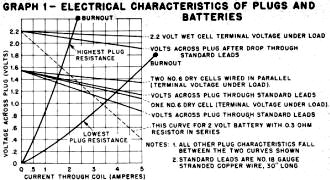
Graph 1- Electrical Characteristics
of Glow Plugs and Batteries
By William NetzebandSince our original glow plug report appeared in the August
1960 issue of American Modeler most of the plugs tested have been replaced or removed
from manufacture. The original charts have been revised to include the latest group
as of early in 1962 ... and will be updated from time-to-time.
It should be noted, that the report shows how to get the best life from a plug,
as well as safely operating an engine. Maximum contest performance does not follow
this safe pattern, so when you are trying for the last ditch REV, use as hot a fuel
and as hot a plug as you can get by with. This holds even if you burn out during
the flight, as in speed or F/F gas. In fact, if your plug is still good after one
of these flights, you ain't getting all the soup available. You sport types, read
and heed the info. It has been revised slightly based on increased learning and
will help your happy flying.
Do you really understand your glow plug? How come there are so many different
types available? As a nosey type I set about to research the glow plug situation.
After burning much fuel, many plugs and considerable midnight oil I found that there
are several things which should interest you. Included in this report are data on
all plugs available at the time of writing, complete information on batteries, a
useful field test gadget and some startling hitherto unpublished facts about glow
engines. None of you can afford to miss out ... so let's go.
A glow plug is machined from steel bar stock and assembled per the cutaway drawing.
Several were sawed in half and polished to get this info. They come with three thread
lengths; 7/32", 3/16", and 5/32"-long reach, medium, and short reach respectively.
The medium reach can be used for either long or short. In general most engines use
long reach with a few smaller types needing the short type. Since the threads and
hex are standard the variety comes in the coil, the insulation and seal material,
the plating, and the size of the cavity. Before continuing into the depths let us
establish the background for the discussions.
The glow plug provides heat to fire fuel about like a spark plug, except it remains
hot continuously. To brush over a lot of territory let me state flatly that as glow
heat is raised, engine timing advances followed by RPM increases. Nitro methane
is blended with alcohol to provide oxygen for more power, but it also lowers the
flash point of the fuel. So more nitro also advances the timing. The trick with
plugs and the reason for this report is to use as much nitro as necessary to do
the job and use the PLUG to control the timing.
Many of us have long operated under the mistaken impression that timing is at
the mercy of nitro. The proper use of plugs as a control item opens new horizons
of engine operation. And it is much simpler than brewing fuel. The proper use of
plugs also increases their life. It has been the custom to feel that a plug is expendable,
but I have two personal pets which have been in continuous operation so long, I
don't really know if they will unscrew anymore. There is a plug available now which
will even hold up in speed engines. Interesting?
The glow plug coil is heated initially by passing an electrical current through
it. The amount of current is determined by the coil resistance and the battery voltage
applied. More on this later. When the battery is removed, however, no current flows
(oh sure, thermal emf, but we don't worry about that). Coil heat must be absorbed
from the fire during the power stroke, and be retained by the coil during the intake
and compression stroke. Platinum also gets heat by catalysm[sic] in the presence
of nitromethane. During this time the coil gets pushed around by the pressure of
expanding fuel and then blasted with cold fuel, so it receives an unmerciful beating.
Consider also that this cycle occurs from 150 to 300 times per second.
The actual design of a glow plug is a ticklish business. Coil material must have
proper electrical resistance to heat enough to start an engine, using a wire whose
length and diameter were picked to have the right area to operate the engine properly.
It must still be tough enough to stay together during that pounding. Three materials
are in common use: platinum and platinum-iridium (90%-10%) alloy. Tungsten is alloyed
into some wire materials in varying amounts.
Platinum melts at 32000 F with an electrical resistance of 6.16 times copper.
It is resistant to decomposition from oxygen and heat (which we have lots of), and
it retains good physical strength and hardness at high temperatures. Tungsten and
iridium toughen the platinum alloys and are used as a control of electrical resistance.
Suppose we kick around this Hot plug-Cold plug idea for a while. Use of the word
HOT causes some confusion due to modem slang usage. Mention Hot and most of you
think of high performance (Jet's stick to machinery, Clyde). Being a literal type
my Hot plug is one which allows larger amounts of fuel to reach the coil surface.
The term is relative in that each plug is compared to every other plug. I considered
using Hotter and Colder, but gave it up. There are several measurable features of
a plug which determine its heat rating:
(1) The diameter and length of wire in the coil.
(2) The diameter of the coil and the diameter of the cavity as related to it.
(3) The physical properties of the seal and insulation material (s) and the size
of the stem.
(4) The location of the coil in the cavity.
Now, (1) and (2) determine the surface area exposed to the fuel, which is the
most important factor. Simply thought of it is comparable to a leetle bitty match
and a big torch. With a larger surface area, more of the fuel is heated and the
initial flame is more efficient. Also the larger mass of wire retains more heat,
hence is hotter for the next power stroke. If, however, the coil is too close to
the sides of the cavity, some heat will be lost thru radiation to the relatively
cool surface. Nickel and gold plating serve to reflect some of this, but plating
is more useful to retard corrosion, lower electrical resistance and pretty up the
product.
It has been found that black surfaces make better plugs in that the dark color
reflects less heat to the coil.
Item (3) has little effect on heat compared to other items and is more important
to the plug's resistance to high pressure and high temperature.
Item (4) is interesting, however, and deserves discussion. Its effect shows up
after the plug has been used and the coil has moved about. Generally the coil is
pushed up or over to one side making the plug colder. Some weird cases have come
up where the coil was moved out of the cavity and into the firing chamber. Heat
went way up and detonation set in. In fact on several occasions a somewhat cool
run has turned into a screaming high RPM type. Examination of the plug showed no
coil except a 1/16" to 1/8" piece sticking straight out So who needs a coil? Remember
this position feature, because in emergencies you can adjust a given plug by pulling
or pushing the coil. A short reach plug will run cold in a long reach engine and
vice versa.
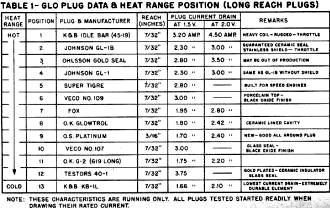
Table 1 - Glow Plug Data &
Heat Range Position (Long
Reach Plugs)
Someone said, "So what!" There's a definite use for all this information. By
knowing the relative heat of all the plugs it is possible to use one fuel over a
wide range of temperature and humidity. General practice has been to change fuel
with weather causing heavy tool kits and much frustration. The plug change is not
considered adequate for flat-out speed operation, but for all other events where
a few RPM won't show. For instance during our test program, which covered a year
of Mid-western weather, our test engines were operated in temperatures from 5° below
zero to 100° in the shade, with wide humidity variations. By varying only the plug
and needle valve it was always possible to get a good, solid, peaked RPM run. Speeds
couldn't be proved different by a stop watch.
Now all you need is one fuel can and a set of plugs. After a while you can settle
on about 3 plugs which will run your engine nicely. It should be stated firmly and
unequivocally that there is no "BEST" plug on the market, per se. There is a "best"
plug for your engine and your fuel on the day you run it, and there are enough
"you's," days and engines to keep them all selling. Some plugs have more
substantial insulation and seals, but you know them already. The weak ones blowout
before the coil folds up. This report has to do with the not so obvious characteristics.
To arrange the Heat Range Table, tests were made as follows ...
(1) Current thru the coil and volts across the plug were measured at various
applied voltages. This curve was plotted as Voltage versus Current. Data points
were averaged from tests on two plugs of each type with calibrated lab instruments.
(2) Tests of common voltage sources, i.e. dry cells and wet cells, were run to
obtain terminal voltage characteristics under various loads. They appear as sloped
straight lines on the sample plot.
(3) The actual resistance of a standard set of battery leads, including contact
resistance of a clip-on device, was measured on a laboratory Wheatstone bridge.
This value was used to determine the voltage drop thru the leads and hence the voltage
across the plug, after deducting voltage drop thru the leads.
(4) By reading the intersections of the voltage versus current curve and the
"volts across the plug" curve the current drain on the battery was determined. We
also wanted to find out the effect of battery aging on starting qualities. Most
plugs allow a 40% safety factor when using 2 dry cells in parallel.
(5) Relative heat characteristics were obtained as follows ... (a) A well broken
in Fox 35 Stunt engine was used with a fuel consisting of 30% Castor oil and 70%
Alcohol. This low-compression (head was shimmed up) cold fuel combo was operated
with a constant head tank, on the bench, to determine the following - starting,
rich run, lean run, and exhaust throttle characteristics. A variable voltage power
supply was used to apply rated current for starts. Plugs were grouped tentatively
from these data. (b) A Fox '58 Combat Special with shaved head, modified for better
breathing and pressurized for constant fuel feed was used with Missile Mist and
Hi Nitro fuels for the hi compression-hot fuel runs. Test runs identical to Cold
combo were made, excluding throttle runs. This information was used to determine
final grouping. Since this hot combo is notoriously hard on plugs, we observed durability
also. (c) Plugs in the center of the table (medium heat) could not be decisively
separated from each other in operating tests, so they are grouped by physical characteristics.
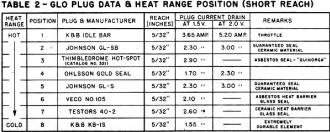
Table 2 - Glow Plug Data &
Heat Range Position (Short
Reach Plugs)

Fig 2. - Glow Plug Field Test Circuit

Fig. 3 - Parallel Connections of Two Batteries for 1.5 Volts
Of some interest is the fact that most decisive separation showed during lo-comp
cold fuel runs. The souped mill blew out most plugs before any observations were
made. Also received a mangled cranking hand with the hotter plugs. Whop!!!
Before covering some points on use of batteries let's mull over several mismatched
combinations, their symptoms and cures. These will be exaggerated conditions. Take
a lo-compression (6 to 1) ratio engine; a cold (low nitro say 5%) fuel and a cold
(maybe 35°) day. Your plug happens to be one at the cold end of our table. Starting
will be slow and sloppy. You may find that you cannot get it to 2 cycle peak or
perhaps it will quit when the battery is re-moved. If you get it off, it will soon
get so rich and sloppy it will probably quit. All of these symptoms point to insufficient
heat. Solution is to use a hotter plug. Simple, what? %) ) fuel and a cold (maybe
35°) day. Your plug happens to be one at the cold end of our table. Starting will
be slow and sloppy. You may find that you cannot get it to 2 cycle peak or perhaps
it will quit when the battery is removed. If you get it off, it will soon get so
rich and sloppy it will probably quit. All of these symptoms point to insufficient
heat. Solution is to use a hotter plug. Simple, what?
Conversely, suppose we take your combat or speed engine on a warm day or even
a cool day. Compression ratio around 12 to 1 and you're using Blast fuel (over 20%
nitro). Pick a plug from the hot end of the range (we dare you). Right off you know
you're wrong cause you get kicked. Go ahead and crank it up, it's only blood. Peaked
out okay, so throw it.
After a few laps she starts to sag. Impossible; we got off rich enough. Sure,
but the plug is heating too much and the effect accumulates in a vicious circle
of advanced timing, more heat, more advance, detonation and boom. If you're lucky
the coil will melt and blow out the stack. Otherwise the poop out continues as long
as any wire is in thar. Solution - Colder plug. It is left to you as an intelligent
individual to sort out the symptoms of too much or too little heat. The hot plugs
will make rich stunt type runs on zero days, while the cold plugs will operate souped
mills on hot days. The range is quite adequate for whatever you need. We have more
dope for you anyhow.
The matter of battery care and operation seems to be little understood so let's
square it away. First some basic electricity. When a wire is carrying current, some
energy is used up in heat. Heat is proportional to current and resistance - that
is the larger they are, the more heat is lost. Also, as the heat increases, the
resistance increases, until, if we apply a fixed voltage, the system stabilizes.
Since our battery internal resistance is fixed, and our lead resistance is fixed,
our coil will heat up until its resistance absorbs the rest of the voltage. If the
resistance is too high, not enough current will flow to generate heat. Conversely
if resistance is too low, too much current will overheat the wire and melt it.
The fact that the wire in getting hot raises the resistance to some required
level is important. Most plugs heat to around 1800° F. for a starting while drawing
current shown in the chart. Since plugs need around 3 amps to heat properly, total
circuit resistance is kept low. Coil on the order of .5 ohms. Lead resistance about
.04 ohms. Considering the two types in common use, only, we'll point up a few things
to give you better starts, fewer blowouts and longer battery life.
The "dry cell" is most popular and most of the plugs are designed for it. Open
circuit voltage is 1.55 volts. Construction-wise it consists of a carbon rod (plus
terminal); a mixture of ground carbon and Manganese Dioxide moistened with a Sal
Ammoniac and zinc chloride solution; and a zinc case (minus electrode). These are
the important parts. By the way, a dry cell is not "dry." It has a moist paste which
won't slosh. Current is generated by chemical action, which also causes hydrogen
gas to form on the carbon rod. This decreases the cell's ability to generate current
and the terminal voltage drops. When not generating, however, the manganese dioxide
removes the hydrogen and the cell "heals." We are demanding large current and must
keep in mind that the cell is not designed to put out for long periods at this rate.
The dry cell curves on the graph reflect this. Even little short circuits are destructive.
Do not test these batteries with an ammeter! Look at the date of manufacture
instead. They will last a year and a half on the shelf. Buy only the freshest ones.
By wiring two cells together in parallel (see sketch) we can generate more current
and increase battery life about 4 times. On a 3 amp load each cell must supply only
1.5 amps. Thus it works more easily and maintains a higher voltage. Remember 4 (four)
times the life for twice the price! Keep your clips clean and check connections
often.
The wet cell or 2 volt battery is a lead-acid battery. An automobile battery
is a batch of these cells connected in series to boost voltage. Terminal volt-age
is 2.2. Chemical action occurs between a lead dioxide plate and a lead plate with
sulfuric acid as the electrolyte. The plates are stacked and connected in parallel
inside the cell. This cell is capable of tremendous current output compared to a
dry cell and can be recharged. Attractive features? HOWEVER, tread very carefully.
Some plugs will not stand 2 volts and some that will stand up get so hot on starting
that they give out with kick-backs and reverse rotation. This occurs when standard
leads are used.
Solution is simple. Use leads four times as long (10'), or use # 20 wire three
times as long (90"). This will drop the volts across the plug closer to the range
of a dry cell. My personal solution was to add a resistor (approx. 0.3 ohm) in the
circuit with a switch, so I could use either 2 or 1 1/2 volt plugs. In addition
I threw in an ammeter for quick field checks. A light type checker is good (both
Ohlsson and Sullivan checkers will take 2 volts), but they don't show a shorted
coil. After losing a few rat races and other aggravating experiences thru partially
shorted coils, I got busy and whipped in the ammeter circuit. My unit has a 3 position
switch with a momentary Test position, an OFF position and an ON position, and a
phone jack so different leads can be used.
Incidentally, if you want to use this circuit on dry cells leave off the phone
jack and get a good toggle switch. The jack and switch can build up resistance too
much. The two testers mentioned earlier are a good investment and are highly recommended.
To get a .3 ohm resistor I used a 1 ohm 25 watt wire wound variable resistor available
at some larger radio supply houses. A piece of iron wrapping wire can be used just
as well. Length of wire determines its resistance, so proceed this way. Wire the
ammeter, glow plug, battery, your standard battery leads, and a long (2 foot) length
of iron wire in series. Consult the chart for 1.55 volt plug current and slide connection
down the iron wire to shorten the length of wire included in the circuit. When the
ammeter shows proper current, the plug should glow.
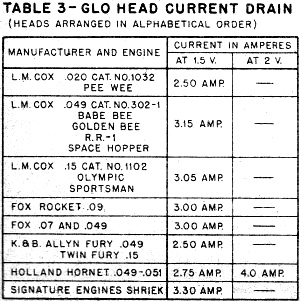
Glow Head Current Drain
Try several other plugs for a cross check and adjust for best average length. The
length of wire may then be placed in the system permanently. Wrap the wire around
a doped wood dowel making certain no coils touch each other. Dope over it and solder
wires to resistor. Tie the connections down to make a good physical installation.
Finally, on dry cells, if you have to delay starts for any reason, disconnect the
battery.
This research was undertaken to find out as much about glow plugs as possible
without treading on trade secrets. One manufacturer asked that coil data not be
revealed, so naturally none of them can be. The fact that both length and diameter
of coil wire determine heat range and current drain led to some bad guesses. Looking
at wire diameter is not enough to suppose how hot it will be. The length must be
checked. One of the cold plugs uses wire identical in diameter to that used in the
hotter plugs, but the length is shorter. See? There are several things worth mentioning.
In the focused head, pressurized Combat Special, using a 50% nitro fuel we beat
the plugs to death to see which would stay together. The KB-IL held up for 30 minutes
under this. No other plug lasted for more than 15 minutes. The plugs on the cold
end of the chart work quite well under these high heat conditions, and should be
used in order to get reasonable needle settings and to eliminate the tendency toward
overheating, which has become so common. For throttle operation, use the K&B
Idle Bar plug, or the Johnson GL-1B or GL-SB. The shields used in these plugs keep
the cold fuel from flooding the coil and cooling it. They tend to be a bit hot on
the high RPM phase, but respond well on the low RPM in both low and high compression
engines.
Incidentally, those of you still hoarding Champion plugs might as well use them.
They are out of date. Most of the manufacturers are now using the best insulating
and sealing materials available and the problem of blowing out the seal is practically
non-existent. Most of them use two materials, one an asbestos compound for insulation,
the other a high temperature sealing compound ... and bonded glass or ceramic is
in use.
It is difficult to state whether welding or crimping is superior for fixing coil
ends and my list shows that the methods are used about equally. Welding gives a
better electrical connection, but good crimping gives a solid mechanical joint.
So - no contest. All plugs are well made and if used properly are more durable than
most of you think. The manufacturers deserve a bouquet for the high degree of quality
in our plugs. As stated earlier the glow plug is basically a nasty device and there
must have been much skull-cracking associated with the design of each plug. I -was
happily surprised to find the spread of characteristics available, because when.
I started I wasn't sure but what they would all be about the same.
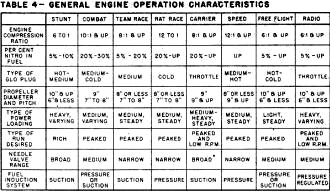
Table 4 - General Engine Operation Characteristics
Mustn't forget to say thanks to those manufacturers who so generously provided
plugs I couldn't buy. (Incidentally fellows, I burned them up just like I promised.)
The data shown for the special "plug-in-the-head" types is more academic than startling.
Since the coil and construction is specially matched to its own engine, and since
heads are not interchangeable, not much else matters. So we listed the battery drain
for your convenience.
Just remembered the kid who came out to fly a 1/2A. He pulled out a 2 foot iron
stake and a big hammer, proceeding to pound the stake in the dirt. Then he pumped
the plane up with fuel and attached one lead of the battery to the top of the plug.
Then he "grounded" the other battery lead to the stake and started his futile cranking.
Manufacturers please note! "CONNECT" beats "ground." Or the fellow who attached
his battery clips together "so the juice wouldn't run out." P.S. - IT DID!
In review then, a hot engine and fuel generally need a cold plug. A cold engine
and cold fuel generally need a hot plug. Running hi nitro fuel in a low compression
(cold) engine is generally a waste of talent. Likewise there is little use for cold
fuel in a hot (high comp.) engine. These facts are based on the "use" requirements.
This field is the source of another batch of research. The various charts will show
you general characteristics which should give you a quick-look check on plugs for
different operations.
Articles About Engines and Motors for Model Airplanes, Boats, and Cars:
|



